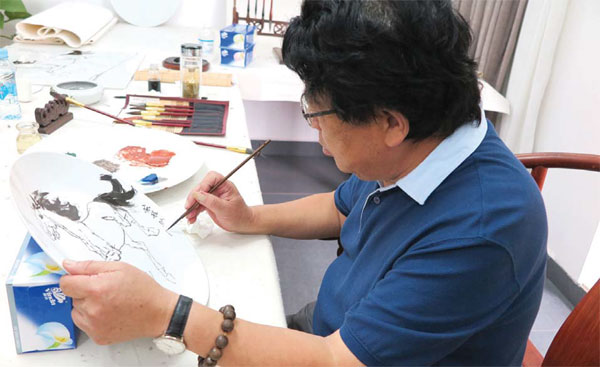Porcelain painting makes a comeback
Nanchang museum exhibits works and nurtures artists
The exhibits at Nanchang Porcelain Painting Museum impress most visitors with their elegant and vivid depictions, but for some they may also evoke childhood memories, especially senior citizens.
Porcelain painting is a unique craft that was once popular in Nanchang, the capital of Jiangxi province, and its surrounding regions.
|
Feng Jie, a master of porcelain painting whose work sells for millions of yuan, paints a running horse onto a plate. Provided to China Daily |
The museum, which covers nearly 10,000 square meters, was built with government funds and opened in 2013. It exhibits pieces and documents the history of the art form, which the Ministry of Culture listed as national intangible cultural heritage in 2008.
The origins of porcelain painting go back to the literati paintings on ceramics in Jingdezhen, the so-called capital of ceramics, in Jiangxi province. At the beginning of the 20th century, Nanchang craftsmen created the art by adding more expressive colors to the traditional light-crimson pigments as a response to public demand. Later, portrait painting was introduced and gradually matured.
In the early days, wealthy people invited artists to paint realistic portraits of their parents on square porcelain pieces, so that they could hang them in their homes as a way of remembering the deceased.
During the 1920s, Nanchang resident Liang Duishi opened a workshop downtown that employed craftsmen to make porcelain paintings. He would check every painting before placing his stamp of approval, and his works soon became popular for their quality.
After that, porcelain paintings, mostly portraits, entered a golden era in Nanchang, with new galleries and workshops opening one after another.
Gradually, the art form developed a complete set of materials and techniques, and it enjoyed a brief renaissance after the wars of the mid-20th century.
"Porcelain painting was still popular in the city when I was small. There were vendors and painters all over the streets," recalls Li Chunmin, 57. He started learning the art when he was 16 and now works at the Nanchang museum. "I was interested in painting as a child. I had a disability in my legs, so my mother advised me to learn porcelain painting after she saw that the painters could work while sitting."
When creating porcelain painting, mineral pigments mixed with oil are applied to flat porcelain pieces. Each painting is composed of three or more layers. Each time a new layer is applied, the piece is fired in a kiln.
Li says a regular-sized portrait usually takes more than 10 days to finish. "It takes experience to get just the right colors, as changes of color usually occur after the furnace procedure. The painters must have a clear idea of what they want to paint beforehand, as no white color is employed, and they must leave out the white areas."
Since the 1990s, porcelain painting has been fading from local life due to the development of photography and computers. In recent years, local government support, coupled with the innovation of craftsmen and women, has rejuvenated the art form.
Modern-day artists have not only broken the content limits and brought in diverse themes, but also combined the craft with artistic and everyday porcelains.
"Porcelain painting has huge potential. We're making efforts and have nurtured a group of young painters," says Feng Jie, a master of porcelain painting. "Normally people regard porcelain painters as craftsmen, but what we hope to do is to cultivate artists."
In recent years, works by masters such as Feng have sold at auction for millions of yuan and have proved a big hit with collectors at home and abroad.
However, Feng says that passing on the traditional skills to future generations is now the priority: "We've already developed different categories beyond portraits. For future innovation, mastering of the traditional skills is crucial."
He and other established artists have teamed up with the museum's research center to promote the art.
Xin Ying, director of the center, said a long-term training program to nurture professional porcelain painters was established in 2011 and has since trained more than 40 painters. Many have gone on to join the center's porcelain painting studio, each focusing on a different style.
"It takes about three years to become a qualified porcelain painter," says Yu Ronghua, 33, a former graduate who now teaches the art. "It's hard because we didn't have an income during that time. But most of us have persevered."
In recent years, the center has displayed porcelain paintings at exhibitions and public events in Beijing, Shanghai and other major cities, Xin adds. It has also been working with local primary schools to promote the art among students.
Contact the writers through liuxiangrui@chinadaily.com.cn



















